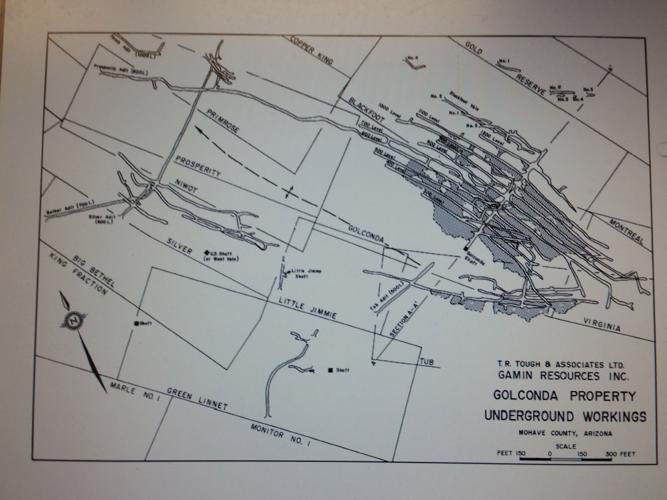Located on rugged terrain in the Cerbat Mountains 15 miles north of Kingman is one Arizona’s greatest zinc mines.
Noted for its deposits of sphalerite, a zinc ore, and chalcopyritethe, Golconda Mine was discovered in 1863 by soldiers from Fort Beale, 2 miles north of Kingman.
Because of similar topography — the mine is located in an area with elevations ranging between 3,500 and 5,000 feet — it was named after Golconda Fort in southern India. Golconda means “shepherd’s hill.”
Mining operations were confined to the oxidized zone on the surface, with the focus on gold and silver.
Early equipment included an arrastra that crushed the ore prior to its distribution to mills.
Zinc was used as coin during antiquity by the Chinese and referred to by the Greeks as “false silver.” Zinc possesses invaluable traits, including its ability to galvanize other metals.
A layer of zinc applied on the surface of another metal as a surface protectant against corrosion is used in construction and the automotive industry, among others. Zinc is also used in making alloys including brass and bronze.
Commercial usage of zinc began in Europe in the 17th century and in the United States during the mid-19th century.
Significant zinc production at the Golconda Mine — comprising the Golconda, Virginia, Prosperity, Tub and Little Jimmy mining claims — commenced when the first car of ore was shipped in 1908 under the management of John Boyle Jr.
The mine was owned by E.F. Thompson and E.B. Smith.
Ore was treated at the old Empire Mill in Todd Basin with selective froth flotation to separate the complex zinc sulfide present in copper-lead-zinc sulfide ores.
Zinc undergoes sublimation when heated, directly reverting to a gas. To prevent this loss, the ore is both roasted and heated with charcoal, leaving behind the metal or extracted by electric current.
Next to the Tennessee Mine, it was one of the greatest producing mines in the Wallapai mining district.
During a two-year period in 1916 and 1917, the mine produced $6.5 million in metals.
It was credited with having been the largest zinc producer in Arizona during those years, with the production of 31 million pounds of the metal.
Zinc ore averaged 14 percent along with $10 per ton of gold and silver.
One report of a 4-foot ore shoot on the 300-foot level assayed at 50 percent zinc.
Because the ores are sulfides, a profit was made off the low production costs of sulfuric acid, fulfilling the demand for chemical and agricultural operations throughout Arizona.
The mining camp of Golconda was established replete with a poolroom, school and store, regulated by a justice of the peace.
In 1905, the mine was operated by the Union Basin Mining Co. The company erected a 200-ton mill by 1910. The camp closed in October 1917 because of an explosion at one of the on-site mill’s flotation tanks. The mill was destroyed, along with several buildings in the camp.
This incident, along with a reduction in the market price of lead and zinc, caused the mine to close. At the time, the mine included a 1,400-foot-deep inclined shaft.
A merger with the Oro Plata Mine through a 3,500-foot underground tunnel at the 1,000-foot level — known as the Golconda Extension, or the Peach Tunnel — had the objective of recovering high-grade ore while providing low-cost transportation for ore recovery in the lower levels of the Golconda Mine.
These operations were carried out by the Oro Golconda Mining Co., which, under the management of A.B. Peach, acquired an additional output of $400,000 profit prior to the closing of the mine due to the Depression.
The mine continued to produce after the Depression, with 21,000 tons of mainly zinc ore produced during World War II.
By 1948, the mine was credited with 56,336,020 pounds of zinc, 2,031,719 pounds of lead, 354,703 pounds of copper, 510,180 ounces of silver and 20,752 ounces of gold.
In the 1980s, operations involving the 1,400-acre property consisting of 61 claims included extensive exploration involving diamond drilling and geophysics undertaken by Gamin Resources Inc. for the potential of an open-pit zinc-gold mine.





